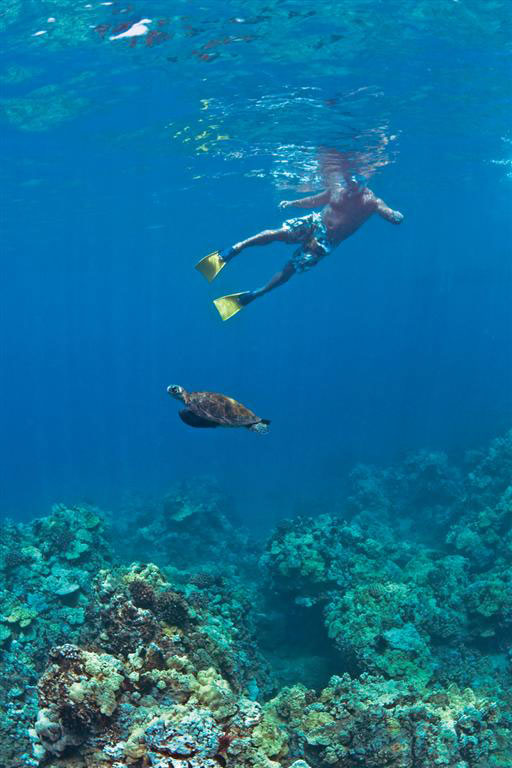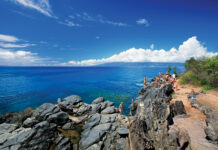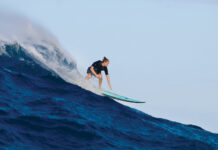Ashley Stepanek
 “Ashley,” my brother, Drew, e-mails from San Francisco, “I’ve got these friends coming over for a visit. Can you help them? What’s cool to do for activities?”
“Ashley,” my brother, Drew, e-mails from San Francisco, “I’ve got these friends coming over for a visit. Can you help them? What’s cool to do for activities?”
When you live on Maui, it’s not long before you become an unofficial activity planner—and sometimes unpaid tour guide—so there’s ample reason to get out and explore Paradise. (Oh, how we suffer!)
With one company or another I’ve tried the Ds (dune-buggying and dirt biking), the Ps (parasailing, paragliding, paddling), and the Ss (sailing, scuba diving, surfing and stand-up paddleboarding). All great times I recommend for excitement.
There are also tours with a capital C for culture. More an adventure of the mind, they’re a great way to learn about history and to experience traditions when visiting what’s still a relatively foreign place. Even though Hawai‘i has been a state for almost half a century, the native culture remains largely unexplored by guests—a shame, since it’s revitalizing at a rousing rate. The islanders’ way of life is worth getting to know.
I e-mailed Drew what I share with you now: honestly, a good activity depends on what suits your interests and disposition at the time. So whether it’s windsurf lessons or a walking tour, make sure it’s something you genuinely enjoy. Um, yeah, and don’t forget to relax.
Adrenaline Junkies Apply Here
Kahoma Ranch
This dune-buggy operation has quickly gained a reputation as a thrilling way to see West Maui. In full fatigues, hanky tied on like a bank robber, aviator goggles and helmet, you wonder if you accidentally signed the wrong waiver. Battle, you ask? No, rattle: the Rhino buggy shakes, swerves and skids as you drive rutted roads, taking in the view amid hairpins.
I get stuck in a trench while turning—but no matter, a guide comes to my rescue. “Press four-wheel drive,” urges Mason, a brawny, green-eyed Hawaiian man. I push the red button in mock panic. “Now, gun it, sista’!” I do, leaving him behind in a big cloud of dust. (Oops, sorry, call me.) The mountain Kahalawai stands majestically under swooping shrouds of grey; the other 180 degrees are all islands and ocean. I’m still reeling from the visuals, and still cleaning the dirt from my ears. This is not a tour for neat freaks. For reservations, call 667-1978 or e-mail kahomaranch.com.
Blue Water Rafting
Owner Captain Mark De Rensis’s high-powered rafts go where the big boats can’t . . . and revel in it. Airlifted every other swell—think of head-banging to Metallica in seated position, holding on to ropes and canvas for dear life—the raft hopscotches south to La Perouse. There the captain backs us into a sea cave. It’s dark and quiet; suddenly a blowhole shoots and large waves give chase. Accelerating just in time, he cackles, “Did the whole boat get sprayed?”
Now off to Molokini. The majority of boats take you inside the submerged crater’s rim for snorkeling in 30 feet of water. But these guys like to turn the volume up. They go behind, where the wall drops more than 150 feet. “Holy,” I say nervously, as I put on my gear, pinky toe dipped into cold aquamarine. “What will I see here?” A crewmember mutters, “We saw a whale shark last week.” Fortunately, they’re about as harmful as goldfish—just a skazillion times bigger. Call 879-7238 or visit www.bluewaterrafting.com.
Skyline Eco-Adventures
Make like 007, without the bad guys and explosions. Play renegade with this Eco-tour Operator winner, ziplining across the gulches and sand dunes of Kahoma (on the same acreage as the buggies). Skyline’s new operation (its first, near Haleakala Crater, was the first zipline in the country) takes you on six crossings, each ranging from 350 to 1,000 feet transversely as it descends about 50 feet. Whoa. Badass.
Dangerous? Not really. You wear a helmet. Guide Stacey hooks my harness to a thick cable by carabiner rigged to a pair of pulleys. Then I take a walk off the platform. Zipping across, spinning and scissoring my legs, I laugh out loud while glimpsing Lana‘i zooming across the horizon; I even see a trio of nene (Hawaiian geese) winging in the distance. Our other guide, Luke, does the catching. People who weigh more tend to go faster. I was out of luck and actually got stuck on the last zip. I guess this doesn’t happen often (hmmm, my personal theory is sabotage) but Luke did an effective job of getting me out of the gulch. Well done, James Bond. Call 878-8400 for reservations, or visit www.skylinehawaii.com.
Sunshine Helicopters
The best way to see Maui is by helicopter. Buzzing Kanaha Pond, sailing over Kahului, we swoop amid canyons to ridges above Waiehu, where waterfalls gush down steep jungle walls. This, just in the first fifteen minutes! As our pilot, Ken, maneuvers around for a better look, it’s comforting to know he flew Hueys in Vietnam. But the fast twists and turns make me queasy. (For those prone to motion sickness, take Dramamine before takeoff.)
The Beach Boys harmonizing in my headphones helps to calm me down as we beeline west over Pailolo Channel to Moloka‘i, around the north shore to lush Halawa Valley. Only accessible by boat, this area is famed for its natural grandeur. Ken flies us over the highest sea cliffs in the world, a spectacular sight, and then lands at Kalaupapa Airport. After sipping sodas, we jump back in the chopper for more. Call 871-0722 or make reservations on-line at www.sunshinehelicopters.com.
Calling All Culture Enthusiasts
Friends of Moku‘ula
Did you know Kamehameha the Great vacationed in Lahaina? A century before the surfeit of restaurants, bars, shops and hotels, the first king of all the Islands and his royal entourage spent downtime on Moku‘ula, a sacred eleven-acre island in Mokuhinia fishpond. You’re probably thinking, “How did I miss that?” Easy—Moku‘ula is buried under a baseball diamond behind the parking lot across from 505 Front Street.
I learn this from guide Kalani Salazar, a direct descendant of the Hawaiian high chief. Walking through town, he paints a vivid portrait of life prior to western explorers, missionaries and whalers. Subtleties you miss come alive. An ordinary rock near the library transforms when Salazar chants, identifying it as Pohaku o Hauola, a birthing stone. One brilliant revelation of many. Reservations: 661-9494; learn more by logging on to www.mokuula.com.
Maui Ocean Center
Hukilau. Recognize this word? It was made famous in “The Hukilau Song” by Jack Owens (“Oh, we’re going to a hukilau. A huki, huki, huki, huki, hukilau.”) Contrary to the opinion that it’s a funny version of lu‘au, hukilau is a form of fishing used by ancient Hawaiians. (I had no idea.) Huki means “to pull” and lau means “leaf”—using a big net tied with ti leaves. (Shadows formed by the ti help to scare fish in.) Hawaiians would often catch enough to feed a village.
I learn this at the Maui Ocean Center, walking through the exhibit about Hawaiians and the sea in the Marine Mammal Discovery Center. But culture is just one reason to visit.
Whether it’s seahorses, moray eels or hammerheads you’re into, Maui Ocean Center has got it. It’s the largest tropical reef aquarium in the Western Hemisphere; the only one in the world to have a tiger shark in captivity. Even more impressive, you can sleep with the tiger and his tank-mates during one of the center’s upcoming overnighters. But, darn it, you have to be a kid! For details, call 270-7000 or visit www.mauioceancenter.com.
Kahanu Garden
This ethnobotanical expanse is a good place to stretch your legs after the long drive to Hana. Past mile-marker 31, take a left on ‘Ula‘ino Road, splash your wheels through a streambed and there’s the sign. No, you won’t see Adam and Eve in the garden (though it’s self-guided, so really anything can happen). Grab pamphlets and look for placards to help explore the 294 acres.
The garden is situated in a vast hala (pandanus) forest. Important to Hawaiians, hala was used for plaiting mats, canoe sails and baskets for hundreds of years. While this history is the focus, they also have plants significant to other cultures in Polynesia, Micronesia and Melanesia. Tour highlights: Pi‘ilanihale, a ginormous lava-rock construction believed to be the biggest ancient site of worship in Oceania; the Canoe Garden with its kalo (taro), sweet potato, sugarcane, banana and ‘awa (kava); and the world’s largest collection of ‘ulu (breadfruit) cultivars—Kahanu serves as a germplasm repository for this South Pacific food crop. For more info visit www.ntbg.org/gardens/kahanu-tours.php; phone is 248-8912.
Ho‘omana‘o
The brainchild of Robert Aguiar, one of three Old Lahaina Lu‘au owners, this a.m. program was created for internal training. But observing the staff’s gain, the owners decided to open Ho‘omana‘o to the public a few years back. It’s to help people remember the life and culture of the kanaka maoli (Native Hawaiians).
A chanter explains the kulana (section) format, then blows the pu (conch) to start. Hula, warfare, ahupua‘a (land division) . . . go in any order you like. I learn to dance from the pros, making music with a gourd, and then move to throwing spear. Bull’s eye! Observe ancient daily life in tableau as women pound kalo (taro) and kapa (barkcloth). Think you can fish, Hawaiian style? I try throwing net . . . but catch myself instead. “Survey says she’s kicked off the island!” For reservations, call 1-800-248-5828 or visit www.oldlahainaluau.com.





